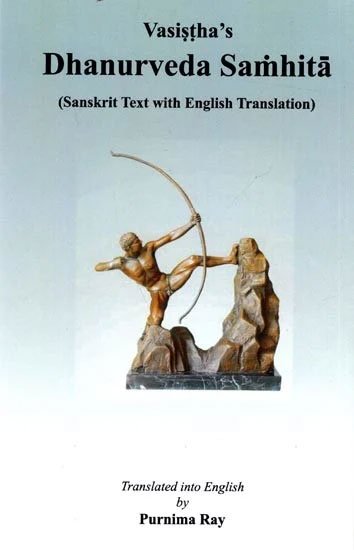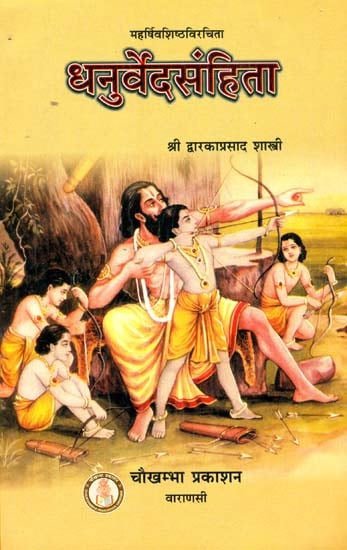Dhanurveda Samhita [sanskrit]
3,015 words
The Sanskrit text of the Dhanurveda-samhita attributed to Vasishtha. Dhanur Veda is a type of ancient India science whose roots date to the 2nd millenium BCE. It is counted among the Upavedas literature. This specific version of the Dhanurveda contains roughly 240 sections of Sanskrit text.
Verse 1.194
वच्मि वायव्यमस्त्रं ते येन नश्यन्ति शत्रवः ।
ओं वायव्यया या वायव्ययान्योर्वाय या वा तथा ।
अमुकशत्रूम् हन हन हूं फट् चैव प्रकीर्त्तयेत् ।
पूर्व्वमेव तथा जप्त्वा नियुतं द्वितयन्तथा ॥ १९४ ॥
vacmi vāyavyamastraṃ te yena naśyanti śatravaḥ |
oṃ vāyavyayā yā vāyavyayānyorvāya yā vā tathā |
amukaśatrūm hana hana hūṃ phaṭ caiva prakīrttayet |
pūrvvameva tathā japtvā niyutaṃ dvitayantathā || 194 ||
Note! The following is not a translation of the above verse, but merely an arbitrary extract of the English text.
I’m telling you about the weapon of the wind, which destroys your enemies. ॐ Vayavyaya ya vayavyayanyorvaya ya va tatha. One should chant the mantra Hana Hana Hum Phat to this enemy. After chanting the same mantra as before, chant the same mantra for the second time.
English translation by Hardayalu Swami (2001) Buy now!
Glossary of Sanskrit terms
Note: This extracts Sanskrit terms and links to English definitions from the glossary, based on an experimental segmentation of verse (1.194). Some terms could be superfluous while some might not be mentioned. Click on the word to show English definitions.
Vayavya, Astra, Tad, Yushmad, Yena, Yah, Yat, Nashyanti, Nashyat, Shatru, Ani, Vaya, Tatha, Amuka, Hana, Hum, Phat, Niyut, Niyuta, Dvita,
Analysis of Sanskrit grammar
Note: this is an experimental feature and only shows the first possible analysis of the Sanskrit text (Verse 1.194). If the system was successful in segmenting the sentence, you will see of which words it is made up of, generally consisting of Nouns, Pronouns, Verbs, Participles and Indeclinables. Click on the link to show all possible derivations of the word.
- Line 1: “vacmi vāyavyamastraṃ te yena naśyanti śatravaḥ ”
- vacmi -
-
√vac (verb class 2)[present active first single]
- vāyavyam -
-
vāyavya (noun, masculine)[adverb], [accusative single]vāyavya (noun, neuter)[adverb], [nominative single], [accusative single]vāyavyā (noun, feminine)[adverb]
- astram -
-
astra (noun, neuter)[adverb], [nominative single], [accusative single]
- te -
-
ta (noun, masculine)[locative single]ta (noun, neuter)[nominative dual], [vocative dual], [accusative dual], [locative single]tā (noun, feminine)[nominative dual], [vocative single], [vocative dual], [accusative dual]tad (noun, neuter)[nominative dual], [accusative dual]sa (noun, masculine)[nominative plural]sā (noun, feminine)[nominative dual], [accusative dual]yuṣmad (pronoun, none)[dative single], [genitive single]
- yena -
-
yena (indeclinable)[indeclinable]ya (noun, masculine)[instrumental single]yaḥ (pronoun, masculine)[instrumental single]yat (pronoun, neuter)[instrumental single]
- naśyanti -
-
naśyantī (noun, feminine)[adverb], [vocative single]naśyat (noun, neuter)[nominative plural], [vocative plural], [accusative plural]√naś -> naśyat (participle, neuter)[nominative plural from √naś class 4 verb], [vocative plural from √naś class 4 verb], [accusative plural from √naś class 4 verb]√naś -> naśyantī (participle, feminine)[vocative single from √naś class 4 verb]√naś (verb class 4)[present active third plural]
- śatravaḥ -
-
śatru (noun, masculine)[nominative plural], [vocative plural]
- Line 2: “oṃ vāyavyayā yā vāyavyayānyorvāya yā vā tathā ”
- Cannot analyse om*vā
- vāyavyayā -
-
vāyavyā (noun, feminine)[instrumental single]
- yā* -
-
yā (noun, feminine)[nominative plural], [accusative plural]yā (pronoun, feminine)[nominative plural], [accusative plural]
- vāyavyayā -
-
vāyavyā (noun, feminine)[instrumental single]
- anyor -
-
ani (noun, masculine)[genitive dual], [locative dual]anī (noun, feminine)[genitive dual], [locative dual]
- vāya -
-
vāya (noun, masculine)[compound], [vocative single]√vā -> vāya (absolutive)[absolutive from √vā]va (noun, masculine)[dative single]va (noun, neuter)[dative single]√vai (verb class 1)[imperative active second single]
- yā* -
-
yā (noun, feminine)[nominative plural], [accusative plural]yā (pronoun, feminine)[nominative plural], [accusative plural]
- vā -
-
vā (indeclinable conjunction)[indeclinable conjunction]vā (noun, feminine)[nominative single]√vā (verb class 1)[imperative active second single]
- tathā -
-
tathā (indeclinable correlative)[indeclinable correlative]tathā (indeclinable)[indeclinable]tathā (noun, feminine)[nominative single]
- Line 3: “amukaśatrūm hana hana hūṃ phaṭ caiva prakīrttayet ”
- amuka -
-
amuka (noun, masculine)[compound], [vocative single]amuka (noun, neuter)[compound], [vocative single]
- śatrū -
-
śatru (noun, masculine)[compound], [adverb], [nominative dual], [vocative dual], [accusative dual]
- um -
-
u (noun, masculine)[accusative single]
- hana -
-
hana (noun, masculine)[compound], [vocative single]hana (noun, neuter)[compound], [vocative single]√han (verb class 1)[imperative active second single]
- hana -
-
hana (noun, masculine)[compound], [vocative single]hana (noun, neuter)[compound], [vocative single]√han (verb class 1)[imperative active second single]
- hūm -
-
hūm (indeclinable)[indeclinable]
- phaṭ -
-
phaṭ (indeclinable)[indeclinable]
- cai -
-
ca (indeclinable conjunction)[indeclinable conjunction]ca (noun, masculine)[compound], [vocative single]ca (noun, neuter)[compound], [vocative single]cā (noun, feminine)[nominative single]
- aiva -
-
√i (verb class 2)[imperfect active first dual]
- Cannot analyse prakīrttayet
- Line 4: “pūrvvameva tathā japtvā niyutaṃ dvitayantathā ”
- Cannot analyse pūrvvameva*ta
- tathā* -
-
tathā (noun, feminine)[nominative plural], [vocative plural], [accusative plural]tatha (noun, masculine)[nominative plural], [vocative plural]
- japtvā -
-
√jap -> japtvā (absolutive)[absolutive from √jap]
- niyutam -
-
niyuta (noun, masculine)[adverb], [accusative single]niyuta (noun, neuter)[adverb], [nominative single], [accusative single]niyutā (noun, feminine)[adverb]niyut (noun, feminine)[accusative single]
- dvita -
-
dvita (noun, masculine)[compound], [vocative single]
- yan -
-
yat (noun, masculine)[vocative single]√i -> yat (participle, masculine)[nominative single from √i class 2 verb], [vocative single from √i class 2 verb]yaḥ (pronoun, masculine)[accusative single]
- tathā -
-
tathā (indeclinable correlative)[indeclinable correlative]tathā (indeclinable)[indeclinable]tathā (noun, feminine)[nominative single]
Other editions:
Also see the following editions of the Sanskrit text or (alternative) English translations of the Verse 1.194
Dhanurveda Samhita (धनुर्वेदसंहिता)
by Hardayalu Swami (2001)
Publisher: Khemraj Shrikrishnadass
Buy now!
Vasistha’s Dhanurveda Samhita
by Purnima Ray (2023)
Publisher: Khemraj Shrikrishnadas; ISBN-10: 818670289X; ISBN-13: 9788186702895; 88 pages including 18 illustrations;
Buy now!
Dhanurveda Samhita (धनुर्वेदसंहिता) (संस्कृत एवं हिंदी अनुवाद)
by Shri Dwarka Prasad Shastri (2007)
Title: Dhanurveda Sanhita (Hindi translation); Publisher: Chaukhambha Prakashan, Varanasi; 84 pages including 11 illustrations; Author: महर्षि वशिष्ठ (Maharshi Vashistha); Foreword by Dr. Chakradhar Bijalwan.
Buy now!![Dhanurveda Samhita [sanskrit] - book cover](/uploads/a/Dhanurveda-Sanskrit.jpg)

